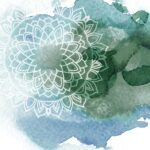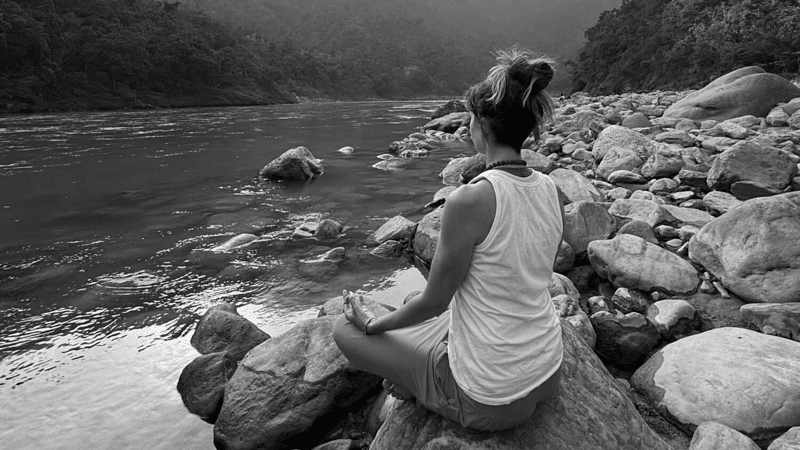
Meditation: a means to oneself
Connecting to our inner wisdom in meditation. By Kay Baxter
I came across a book recently; the title: ‘Don’t just do something, sit there’ aptly sums up something of the essence of meditation.
Our lives can be so busy and demanding, or fragmented and chaotic that we feel we have not got time or are too distracted to meditate. Or we find that when we do sit we feel restless and uneasy and with nagging thoughts of what we should be doing, and so we give up before we have really given it a chance. Often it is easier to keep busy rather than open to ourselves, but truly there is much to be discovered in this ‘not doing’.
There are untapped depths and great richness within all of us where real knowledge and wisdom patiently await our attention.
When we sit to meditate, alert and watchful, consciously feeling and experiencing that which is present, that which arises within us, we become aware of many things that we would not usually notice. We observe where there is tightness and tension in the body, where we feel fatigued and contracted. We notice the flow of our breath; how it is sometimes restricted, where there is a tendency to hold the breath. We see and feel many different states and emotions; a great range depending on what is happening in our life at this time of sitting. States that can range from ease and well-being, through vague feelings of discomfort and unease, to a sense of distress, disturbance or overwhelm.
Awareness is the cornerstone of the inner growth process. Without awareness how can we know our tendencies, our inclinations, the difficulties and distortions that have arisen out of our own pain and suffering, or to really feel the natural qualities we have come into this life to express. Without this opportunity to connect, to open our awareness, we may never really begin to know where we are harsh and aggressive to ourselves and to others; in our thoughts, opinions, judgements, actions. Or how we can be greedy, dishonest and inconsiderate; and there are great subtleties here. Or where we may fall into blame and self-pity or arrogance; an ego filled all knowing that excludes anything or anybody else. Equally we may not take the time to ‘catch’ a moment when we feel full and inspired, have a feeling for doing something different and new, and in order to enter fully and move with it.
In meditation we take time, time to experience our feelings, discover why we feel the way we do and find a way through. We learn to lessen our judgement and criticism, to soften our attitude, to move into some clarity and open a route to creative expression. And in the process we develop more understanding, acceptance, sensitivity and compassion. It is by opening to ourselves and looking directly and honestly that we are able to confront what is; bring it into the light, and from there, create the possibility for movement and change. In sinking deep we can slip into a place of relaxation and ease, where we may experience a sense of peace.
There are many reasons and ways in which to sit, depending on what ‘is’ in any moment, what is your need and indeed the amount of time you have available. We may sit for 5 or 10 minutes to take a break, create an opportunity to settle, to rest within; to connect with how we are and create space for any build up of tension to dissolve and dissipate.
We may choose to sit for 20 minutes or even longer to give time to deepen and explore some state or difficulty, and to better access the inner intelligence that may inform us. Or we may choose to focus on a part of the body that is tense, offering our accompanying support.
As we learn to sit, and be with all things as they arise, we create space for ourselves, where our feelings and states can be seen and felt more keenly, and such that tightness may begin to soften and loosen, leaving us clearer and easier. And from this we can begin to open and clear a path to some stillness, that is enormously refreshing and restorative. It is a process of dealing with some of the clutter that keeps us in ‘busy’ mind and preoccupation, of clearing a path such that insight and understanding may rise up and inform us.
At this point a word on action and doing, because we do not live our lives sitting in meditation. There are many things to do; we are required to act and interact, we want to move and express our life force in the world, we have many needs to meet. But when our life force is bound and tied within us because, for example, we are angry and have not been able to look at and experience this anger, to open to, and offer some degree of passage, we are burdened. Or if we are deeply fatigued or anxious or unsure about a decision we need to make but have not stopped to feel and consider and address the disturbance, then we are disabled.
There are many things we carry within us, known and not known, that hold us back, weigh us down, bind our energy and prevent us from moving and acting freely and easily. The practice of meditation can clear a path and prepare us for fluid being action.
Attending to things as they arise, by pausing to experience, we become less cluttered and burdened in our everyday lives. We are dealing with issues rather than stacking them up and so we become freer and more present. It is when we are present; with no foot or finger in future or past, uncluttered and quiet, that we ‘know’ and ‘do’ what is just and true in any moment.
In the ancient spiritual text, the Bhagavad Gita, Ajuna’s dejected, giving up on the battlefield, demonstrates how difficult it can be to arise and open to ‘fight the battle’ of our lives. How we can be driven to recoil, withdraw and slump into inaction, confusion and doubt, such that we cannot move and are disabled by our own thoughts and hesitancy. But armed with the sword of awareness and understanding we are enlivened, enabled and ready to live our truth.
To fight the battle is to open to face and feel that which is within, as well as the outer work in the world. Both are intricately linked and the more clearly we are able to see our tendencies and inclinations, our difficulties and doubt, our fear and hesitation and so on, the more we can begin to understand and work with them and the more we are enabled to work skilfully in the outer.
Connecting to our inner wisdom in meditation, in ‘feeling’, reflecting and experiencing, in opening to what is within, we begin the process of knowing ourselves better, and of understanding more. And such that we may move from a place of growing authority, not the authority of some outer figure or establishment but the ultimate authority of that deep inner wisdom that is the jewel in the heart of us all.







